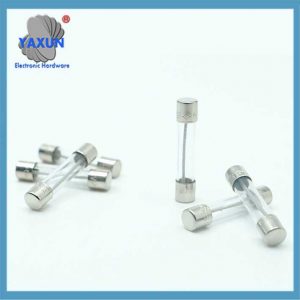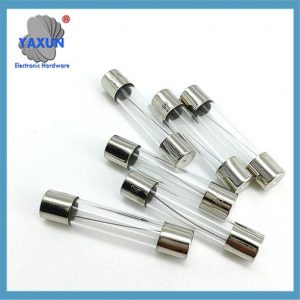De belangrijkste verschillen tussen snelwerkende en langzaam werkende zekeringen liggen in hun reactiesnelheid en toepassingsscenario's: snelwerkende zekeringen springen onmiddellijk door om gevoelige componenten te beschermen, terwijl langzaam werkende zekeringen het doorslaan vertragen om stootstromen te weerstaan.
Analyse van de belangrijkste verschillen
Blaaskarakteristieken en reactiesnelheid.
Snelwerkende zekeringen:
Ze hebben extreem snelle responstijden, blazen binnen milliseconden (doorgaans 0,1 ms-5s) wanneer er sprake is van overstroom. Ze zijn geschikt voor het beschermen van elektronische precisiecomponenten zoals IC-chips en halfgeleiderapparaten. (UL-standaard).
Ze volgen het Joule-verwarmingseffect (Q = I²Rt), hebben een eenvoudig zekeringontwerp, en gebruik metaaldraad met een smalle doorsnede voor snelle warmtegeleiding.
Ze zijn gevoelig voor momentane stromen en zijn niet bestand tegen stootstromen tijdens het in- en uitschakelen of het opstarten van de motor.
Langzaam werkende zekeringen:
Ze zijn bestand tegen kortdurende overstromen (BIJV., 7 keer de nominale stroom voor 0.5-3 seconden tijdens het opstarten van de motor).
Het beschikt over een tijdvertragingsfunctie, nemen 5 naar 10 seconden om te smelten 2 keer de nominale stroom, en is bestand tegen hoge stroompieken op korte termijn (zoals motoraanloopstromen tot 7 keer de nominale stroom).
Het heeft een hoge smeltwarmtewaarde, het bereiken van een vertraagde opening van de zekering door warmteabsorptie in kwartszand of een spiraalvormig ontwerp.
Snelle toepassingen:
Resistieve belastingcircuits (elektrische verwarmingstoestellen, LED-verlichting);
Bescherming van gevoelige halfgeleiderapparaten (zoals MOSFET's en lithiumbatterijpakketten voor kortsluitbeveiliging);
Resistieve belastingen (waterkokers, rijstkokers);
Bescherming van gevoelige circuits zoals lithiumbatterijpakketten en printplaten;
Toepassingen die een snelle onderbreking van kortsluitstromen vereisen.
Langzaam werkende toepassingen:
Inductieve/capacitieve belastingen (motoren, schakelende voedingen);
Toepassingen die overspanningsbeveiliging vereisen (zoals magnetiserende overspanningsbeveiliging voor transformatoren van meer dan 100 kVA);
Inductieve/capacitieve circuits zoals motoren, voedingen, en omvormers;
Apparatuur die onderhevig is aan opstartstroom (zoals schakelende voedingen en transformatoren);
Omgevingsomgevingen die pulsstroomtolerantie vereisen.
Verschillen in beschermingsfunctie Snelle zekeringen: Biedt alleen bescherming tegen kortsluiting en kan geen onderscheid maken tussen overbelasting en transiënte pulsen.
Trage zekeringen: Bied bescherming tegen zowel overbelasting als kortsluiting, met behulp van de I²t-waarde (de integraal van het kwadraat van de stroom en de tijd) energie bepalen.
Sleutelparameters en selectiesleutelpunten
I-T-curveverschillen
Snelzekeringen hebben een steilere curve, met een smelttijd van ≤0,1s bij 2x de nominale stroom; langzame zekeringen hebben een vlakkere curve, met een weerstandstijd van ≥10s bij 2x de nominale stroom.
Interchangerisico
Als u een langzame zekering vervangt door een snelle zekering, kan het apparaat mogelijk niet starten; het vervangen van een snelle zekering door een langzame zekering kan het risico op schade aan gevoelige componenten vergroten.
Kosten en structuur
Trage zekeringen zijn duurder vanwege hun speciale legeringen of complexe structuren.
Selectieoverwegingen
Parameterberekeningsprioriteit:
Controleer of de I²t-waarde van de maximale stroomstoot van het circuit kleiner is dan de weerstandswaarde van de zekering (Bijvoorbeeld, een voeding moet een piektest van 15A/150ms doorstaan).
Het onderbrekingsvermogen moet hoger zijn dan de maximale kortsluitstroom van het systeem (BIJV., voor een kortsluiting van 35kA, kies een onderbrekingsvermogen van 50 kA).
Veelvoorkomende misvattingen:
Hoge temperaturen kunnen ervoor zorgen dat de nominale stroom van een langzame zekering daalt 30%.
Verkeerd gebruik van een snelzekering in een UPS kan valse uitschakeling veroorzaken (één geval resulteerde in verliezen van 1.8 miljoen yuan).
Uit experimenten blijkt dat wanneer een lithiumbatterij kortsluit, de kans op thermische overstroming veroorzaakt door een langzame zekering is acht keer groter dan die van een snelle zekering.
Bij het testen van omvormers, Het verkeerd gebruiken van een langzame zekering kan de schade aan de module vergroten 1% naar 37%.
 English
English Afrikaans
Afrikaans العربية
العربية বাংলা
বাংলা bosanski jezik
bosanski jezik Български
Български Català
Català 粤语
粤语 中文(简体)
中文(简体) 中文(漢字)
中文(漢字) Hrvatski
Hrvatski Čeština
Čeština Nederlands
Nederlands Eesti keel
Eesti keel Suomi
Suomi Français
Français Deutsch
Deutsch Ελληνικά
Ελληνικά हिन्दी; हिंदी
हिन्दी; हिंदी Magyar
Magyar Bahasa Indonesia
Bahasa Indonesia Italiano
Italiano 日本語
日本語 한국어
한국어 Latviešu valoda
Latviešu valoda Lietuvių kalba
Lietuvių kalba македонски јазик
македонски јазик Bahasa Melayu
Bahasa Melayu Norsk
Norsk پارسی
پارسی Polski
Polski Português
Português Română
Română Русский
Русский Cрпски језик
Cрпски језик Slovenčina
Slovenčina Slovenščina
Slovenščina Español
Español Svenska
Svenska ภาษาไทย
ภาษาไทย Türkçe
Türkçe Українська
Українська اردو
اردو Tiếng Việt
Tiếng Việt



